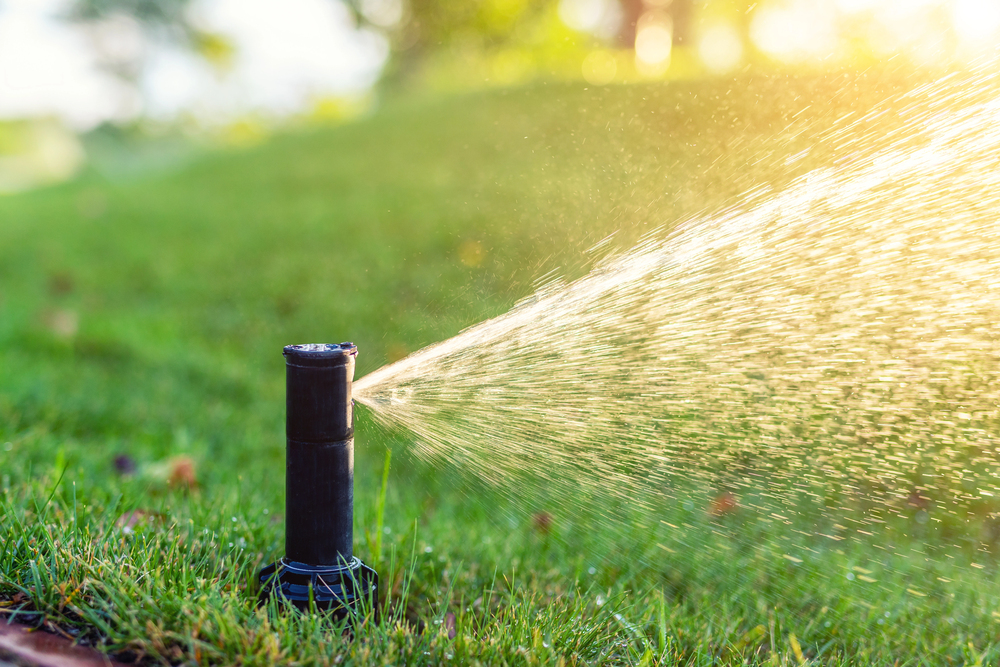Summer lawn watering requires consistency and precision to maintain healthy grass during the hottest months. Most lawns need water 2-3 times per week during summer, with each session providing approximately 2.5 to 3.8 centimetres of water, including rainfall.
The ideal watering frequency for summer lawns is every 2-3 days, delivering deep, thorough irrigation rather than daily light sprinkling.
This approach encourages roots to grow deeper into the soil, creating a more drought-resistant lawn that can better withstand heat stress.
Understanding your specific grass type, soil conditions, and local climate will help fine-tune this general guideline. Recognising the signs of both overwatering and underwatering ensures your lawn receives exactly what it needs throughout the summer season.
Determining the Watering Frequency in Summer
Summer lawn watering frequency depends on grass type, soil conditions, and local climate factors. Most lawns require 1-2 deep watering sessions per week during hot summer months.
Factors That Influence Summer Lawn Watering Needs
Soil type significantly affects how often homeowners need to water their lawns. Clay soils retain moisture longer and require less frequent watering, whilst sandy soils drain quickly and need more regular attention.
Temperature and humidity levels directly impact lawn watering schedules. Areas with temperatures above 30°C require more frequent watering than cooler regions.
Rainfall affects watering frequency considerably. Homeowners should reduce their watering schedule during weeks with substantial precipitation.
Key soil factors include:
- Clay soil: holds water 2-3 days longer
- Sandy soil: requires watering every 2-3 days
- Loamy soil: needs water every 3-4 days
Wind exposure increases water evaporation from grass blades. Lawns in windy locations lose moisture 25-30% faster than sheltered areas.
Sun exposure determines water loss rates. Full-sun lawns need 40% more water than shaded areas during summer months.
Watering Frequency Guidelines by Grass Type
Cool-season grasses require different watering schedules compared to warm-season varieties during summer. Understanding grass type helps homeowners create effective lawn care routines.
Cool-season grasses like fescue and ryegrass need more frequent summer watering. These grasses struggle in heat and require water every 2-3 days when temperatures exceed 27°C.
Warm-season grasses such as Bermuda and Zoysia thrive in summer heat. They typically need deep watering once or twice weekly.
Buffalo grass and other drought-tolerant varieties need the least water. These grasses can survive on weekly watering sessions during most summer conditions.
Adjusting Watering Based on Lawn and Weather Conditions
Soil moisture levels indicate when lawns actually need water rather than following rigid schedules. Homeowners can test soil moisture by inserting a screwdriver 15cm deep into the ground.
Weather-based adjustments:
- Reduce watering by 50% during rainy weeks
- Increase frequency during heatwaves above 32°C
- Skip watering when overnight temperatures drop below 18°C
Signs of proper hydration include healthy grass colour and spring-back when walked upon. Overwatered lawns develop fungal issues and shallow root systems.
Brown patches or wilting grass blades indicate insufficient watering. However, dormant grass during extreme heat is normal and doesn’t always require additional water.
Establishing deep watering sessions twice weekly works better than daily light watering. This approach encourages deeper root growth and better drought tolerance.
Morning watering between 6-10 AM provides the best results for summer lawn care. Evening watering can promote fungal diseases in humid conditions.
The Importance of Grass and Soil Types
Different grass varieties and soil compositions significantly affect watering frequency and water retention capacity. Warm-season grasses require less frequent irrigation than cool-season varieties, whilst clay soils hold moisture longer than sandy compositions.
Differences Between Warm-Season and Cool-Season Grasses
Warm-season grasses thrive in temperatures between 26-35°C and enter dormancy when temperatures drop below 10°C. These varieties include Bermuda grass, Zoysia, and Buffalo grass.
Cool-season grasses grow best in temperatures ranging from 15-24°C. They remain active during spring and autumn but struggle in summer heat above 27°C.
Watering frequency varies considerably between these types:
- Warm-season grass: Requires deep watering 1-2 times per week during peak summer
- Cool-season grass: Needs watering 2-3 times per week in summer heat
Warm-season varieties develop deeper root systems, typically extending 15-30cm into soil. This allows them to access moisture from lower soil layers.
Cool-season grasses maintain shallower roots, usually 10-15cm deep. They depend more heavily on surface moisture and frequent irrigation during hot weather.
Recognising Your Grass Type: Common Examples
Cool-season grasses common in the UK include:
- Perennial ryegrass: Dark green with fine texture
- Tall fescue: Coarse blades, drought-tolerant
- Fine fescue: Thin, needle-like blades
Bluegrass varieties prefer cooler climates and turn brown quickly under heat stress. They require consistent moisture to maintain colour during summer months.
Warm-season options suitable for southern regions:
- Bermuda grass: Dense growth, goes dormant in winter
- Zoysia: Thick, carpet-like appearance
- Buffalo grass: Native variety, extremely drought-tolerant
Identifying grass type helps determine proper watering schedules. Cool-season grass shows stress signs like browning within 3-5 days without water.
Warm-season grass can typically survive 7-10 days between watering sessions due to deeper root development.
Impact of Soil Type on Water Retention
Clay soil retains water for extended periods, holding moisture 2-3 times longer than sandy compositions. This dense soil structure prevents rapid drainage but can lead to waterlogging.
Sandy soil drains quickly, requiring more frequent watering sessions. Water moves through sandy particles within 30-60 minutes of application.
Loam soil provides the best balance for grass growth. It retains adequate moisture whilst allowing excess water to drain away.
Deep watering works best in clay soils, applying 2.5-4cm of water per session. Sandy soils benefit from lighter, more frequent applications of 1-2cm per watering.
Testing soil drainage involves digging a 30cm hole and filling it with water. If water remains after 24 hours, drainage improvement may be necessary.
Best Practices for Watering Lawns During Summer
Summer lawn watering requires timing your sessions for early morning hours and focusing on deep, infrequent watering rather than frequent shallow sessions. A consistent schedule based on soil moisture levels ensures healthy grass growth during hot weather.
Best Time of Day to Water Your Lawn
Early morning hours between 4:00 AM and 8:00 AM provide the best conditions for lawn watering. During this period, temperatures remain cooler and wind speeds stay minimal.
Water applied during early morning allows grass blades to dry before evening. This reduces the risk of fungal diseases that thrive in moist conditions overnight.
Avoid watering during midday hours when temperatures peak. High temperatures cause rapid evaporation, wasting water and reducing soil moisture absorption.
Evening watering between 6:00 PM and 10:00 PM creates prolonged wet conditions on grass blades. This extended moisture period encourages disease development and pest problems.
Morning watering also takes advantage of natural dew conditions. The existing moisture helps water penetrate soil more effectively than during dry afternoon periods.
Deep Watering Versus Shallow Watering
Deep watering applies 25-30mm of water per session, penetrating 15-20cm into the soil. This method encourages roots to grow deeper, creating drought-resistant grass.
Shallow watering delivers only 6-12mm per session, wetting just the top 5cm of soil. This approach leads to weak, surface-level root systems that struggle during dry periods.
Check soil moisture by inserting a screwdriver or soil probe 15cm deep. If the tool penetrates easily, adequate moisture exists. Resistance indicates dry soil requiring water.
Deep watering sessions should occur less frequently than shallow watering. Most grass types require deep watering every 3-4 days during summer heat.
Establishing a Proper Watering Schedule
Most lawn types need 25-30mm of water weekly during summer months. Split this amount across 2-3 deep watering sessions rather than daily light applications.
Clay soils require longer, less frequent watering sessions to prevent runoff. Sandy soils need more frequent watering as they drain quickly and lose soil moisture rapidly.
Monitor rainfall amounts and adjust your watering schedule accordingly. Use a rain gauge to measure natural precipitation and reduce irrigation when adequate rainfall occurs.
Newly seeded areas require daily light watering until germination occurs. Established lawns benefit from the deeper, less frequent approach that promotes strong root development.
Set sprinkler timers for early morning activation between 4:00 AM and 6:00 AM. This timing ensures water reaches the soil before temperatures rise and evaporation increases.
Check soil moisture levels weekly by examining the top 10cm of earth. Dry, compacted soil indicates insufficient watering, while soggy conditions suggest overwatering.
Identifying Signs of Overwatering or Underwatering
Lawn health problems often stem from incorrect watering practices. Both excessive and insufficient water create distinct visual symptoms that help homeowners adjust their watering schedules.
Visual Signs of Overwatering
Yellowing grass appears as the first indicator of excessive moisture. The blades lose their vibrant green colour and develop pale yellow patches across affected areas.
Fungal growth becomes visible through white, grey, or dark spots on grass blades. These fungi thrive in consistently wet conditions and spread rapidly through waterlogged soil.
Soil that remains constantly soggy indicates poor drainage combined with excessive watering. Footprints or equipment marks stay visible for hours after walking on the lawn.
Soft, mushy roots develop when grass receives too much water. Healthy roots appear white and firm, whilst overwatered roots turn brown and break easily when pulled.
Increased weed growth occurs in overwatered areas. Weeds like clover and moss flourish in wet conditions where healthy grass struggles to compete.
How to Spot Underwatering
Brown, crispy grass blades indicate severe water stress. The grass turns tan or brown starting from the tips and spreading downward toward the base.
Footprint impressions remain visible long after walking across the lawn. Well-watered grass springs back immediately, whilst dry grass stays flattened.
Soil pulling away from pavement edges shows extreme dryness. Gaps appear between concrete and soil as the ground shrinks from lack of moisture.
The grass develops a dull, greyish appearance before turning brown. This colour change occurs 24-48 hours before permanent damage begins.
Slow recovery from foot traffic becomes noticeable. Healthy grass bounces back within minutes, but stressed grass takes hours or fails to recover entirely.
Increased thatch buildup occurs when grass stops growing properly. Dead grass accumulates at soil level instead of decomposing naturally.
Promoting Deep, Healthy Root Systems
Infrequent deep watering encourages roots to grow downward seeking moisture. Watering twice weekly for longer periods works better than daily shallow applications.
Morning watering schedules allow grass to dry before evening temperatures drop. This timing prevents fungal diseases whilst ensuring adequate moisture absorption.
Proper soil drainage prevents water from pooling around roots. Aerating compacted soil twice yearly helps water penetrate deeper into the ground.
Gradual watering adjustments help establish healthy grass without shocking the root system. Changing watering frequency by small amounts allows roots to adapt slowly.
Shallow root systems develop from frequent light watering sessions. Deep roots access moisture during dry periods and create more resilient healthy grass that withstands summer heat stress.
Root depth measurements help determine watering success. Healthy summer grass develops roots 6-8 inches deep in properly managed lawns.





